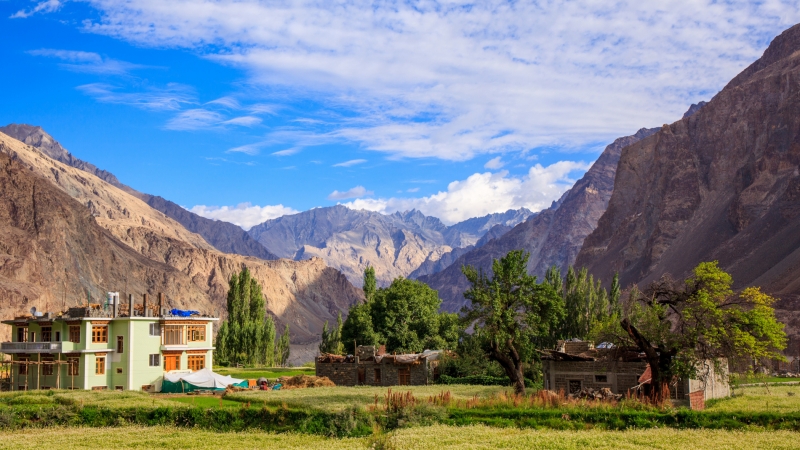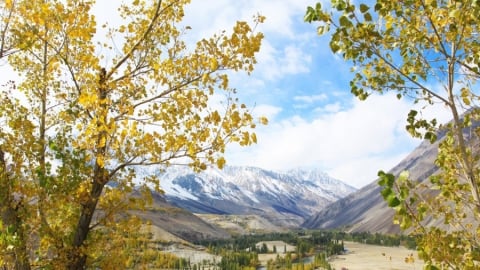At the end of October recently, in the middle of Khaplu valley, Mr. Trinh Nam Thai and Ms. Pham Bich Ngoc were almost speechless at the scene that opened before their eyes: rows of birch trees glowing yellow in the sunlight, the Shyok River winding softly between the mountains, and in the distance the snow-covered Karakoram peak sparkling.
During the 18-day journey following the golden autumn of Pakistan, what they brought back were not only pictures, but also indescribable emotions - when people touched the beautiful harmony between nature, architecture and the cultural breath of the Baltistan region.


Autumn scenery in the Pakistan border region
Khaplu - The Peaceful Pearl of Baltistan
Khaplu is located at an altitude of over 2,600 m, in Ghanche district, Gilgit-Baltistan region, Pakistan - a place that people liken to a hidden gem among the majestic mountains. Previously, this was the capital of the small kingdom of Khaplu Khanate; until now, the town still retains a rare ancient and peaceful look.
While walking through the small stone-paved alleys, from afar, Khaplu Fort, also known as Yabgo Khar, appears like an ancient palace amidst the yellow leaves. Built more than 700 years ago, it was once the residence of the Baltistan kings. Now, the building has been restored by the Aga Khan Foundation and turned into a heritage hotel and a small museum. “When I entered the yard, I could clearly feel the breath of time on each wooden panel, stone wall, and the autumn light coming through the old window frames,” Mr. Thai recalled his feeling at that time.



Leaves change color in Khaplu Valley
Not far away is the Khaplu Mosque - an ancient mosque with a blend of Tibetan, Kashmiri and Islamic architecture. Its wooden roof is intricately carved, its balcony opens onto the valley, where the sound of prayers echoes softly like the wind.
The Balti people are descendants of ancient Tibetans, they live a slow and peaceful life. They speak Balti, a Tibeto-Burman language, and most of them follow Shia or Sufi Islam. Although religion has changed, music, festivals and ancient customs are still preserved. Women are the soul of the valley: they grow barley, collect firewood, tend gardens and harvest autumn fruits. In Thai's lens, the image of a Balti woman carrying a bundle of firewood on her back, walking through a village road covered in gold leaves, is a moment both simple and profound, as if time here flows slower than the rest of the world.


Photos capture the simple daily life of the Balti people in Pakistan
Haldi Cones - stone spears in mid-autumn
From Khaplu, Thai and Ngoc drove about forty minutes southwest to Haldi - a small village nestled at the foot of the Haldi Cones. The road winds around the valley, where patches of yellow grass intermingle with black rocks and white snow. In the midst of that landscape, the Haldi Cones loom tall with dozens of sharp peaks over 5,000 meters high like giant spears reaching into the sky.

The Haldi Cones loom tall with dozens of spear-like peaks.
The scenery here is especially spectacular at dawn and dusk, when golden light covers the mountain peaks. People call Haldi Cones “Pakistan’s little Patagonia”, but for Thai, the scene is more than a comparison. In the quiet space, the cold wind blowing through the dry treetops, Thai and Ngoc looked up at the changing mountain range. The last light of the day slid through the rocky outcrops, reflecting off the thin layer of snow, leaving them with a scene both majestic and fragile as if autumn was slowly melting into the Karakoram sky.

Late autumn sunset over the Haldi Cones
Machlu - village on the Shyok river
From the center of Khaplu, go about 12 km to the southeast, cross the small bridge over the Shyok River to reach Machlu (Machulu) village - a green oasis in the middle of a dry valley, considered one of the most beautiful sunset viewing spots in Baltistan.
Golden terraced fields are layered along the mountainside, and in the distance, you can see the 7,821 m high Masherbrum peak - one of the famous mountains of the Karakoram range - towering. Machlu still retains its pristine wildness, with no sign of commercial hotels or motels. Here, one can spend the night in small, cozy homestays, sip black tea with milk and sugar - a familiar drink of Northern Pakistan and listen to the stories of the gentle Balti people, who proudly tell about the land they have been attached to all their lives.


Autumn scenery in villages in Pakistan
As the sun sets and the light touches the top of Masherbrum, the whole valley seems to light up in a golden moment, Mr. Thai said.
When the golden season still remains
Mr. Thai said, “Taking photos here is not just about finding the frame, but about capturing the breath of the land.” Autumn in Khaplu is not noisy, not ostentatious, but quiet like the way the Balti people live, profound like the silent Karakoram range on the horizon.
When leaving Khaplu, Mr. Thai looked back: the rows of trees along the road were still yellow, the Shyok River still flowed slowly, and the mountain tops in the distance were still covered in morning mist. Even though autumn has passed, that beauty remains in every frame, every heartbeat, like a promise of nature to those who have set foot on this land - Khaplu, the golden autumn in the Karakoram.



Mr. Trinh Nam Thai and Ms. Pham Bich Ngoc standing in front of the autumn leaves of Pakistan
At this time, Hunza - a valley located in northern Pakistan, close to the Chinese border and nearly 500 km from Khaplu - is also in its golden season, and people say: "In just about a week, Khaplu will enter the most beautiful time of autumn. It is the moment of changing seasons, where light, the smell of leaves, the sound of wind and memories blend together," said Mr. Thai.

 EN
EN



































